We Are In The Air Lookout Below! (Page Three)
Hans and John escape the bonds of Earth and rise majestically into the sky in a 72 year old aircraft! Hang on guys!!
We should point out that this experience was carried in the local newspaper.


Liftoff
... They escaped the bonds of Earth
Who Does What In The Ten Man Crew?
Did You Know? -
There was a ten man crew for the majority of operations:
Officers:
Pilot
Copilot
Navigator / Flexible Gunner
Bombardier / Flexible Gunner, Chin Turret Gunner (B-17G)
Enlisted Men:
Flight Engineer / Top Turret Gunner
Radio Operator / Flexible Gunner
Ball Turret Gunner
Left Waist Flexible Gunner
Right Waist Flexible Gunner
Tail Turret Gunner

Crew Position #1 & #2 - The Pilot And Copilot
Did You Know? -
Duties and Responsibilities of
THE AIRPLANE COMMANDER
From the B-17 Pilot Training Manual -1943
Your assignment to the B-17 airplane means that you are no longer just a pilot. You are now an airplane commander, charged with all the duties and responsibilities of a command post.
You are now flying a 10-man weapon. It is your airplane, and your crew. You are responsible for the safety and efficiency of the crew at all times--not just when you are flying and fighting, but for the full 24 hours of every day while you are in command.
Your crew is made up of specialists. Each man -- whether he is the navigator, bombardier, engineer, radio operator, or one of the gunners -- is an expert in his line. But how well he does his job, and how efficiently he plays his part as a member of your combat team, will depend to a great extent on how well you play your own part as the airplane commander.
Get to know each member of your crew as an individual. Know his personal idiosyncrasies, his capabilities, his shortcomings. Take a personal interest in his problems, his ambitions, his need for specific training.
See that your men are properly quartered, clothed, and fed. There will be many times, when your airplane and crew are away from the home base, when you may even have to carry your interest to the extent of financing them yourself. Remember always that you are the commanding officer of a miniature army -- a specialized army; and that morale is one of the biggest problems for the commander of any army, large or small.

Pretty cozy!

The pilots eye view.... Flying along at 250 miles per hour
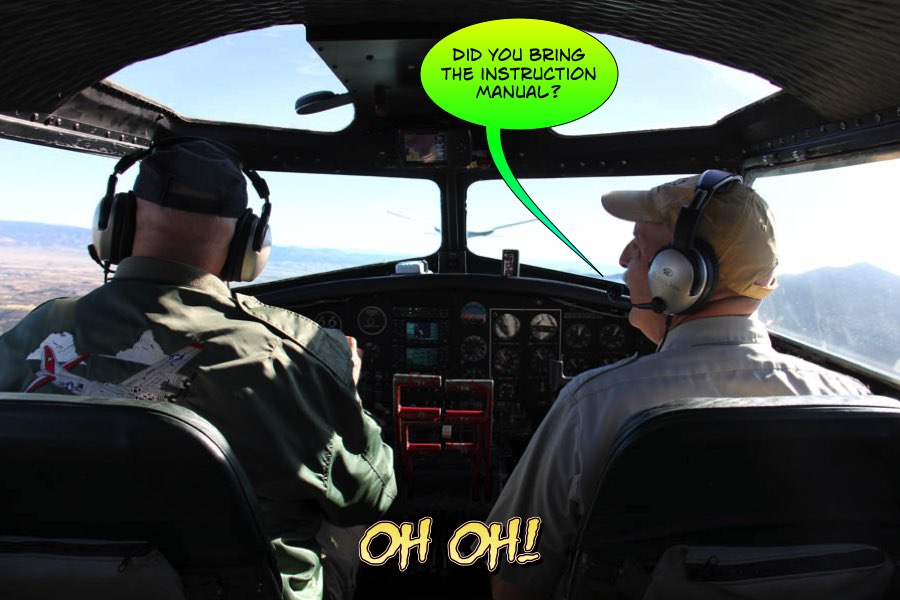
Houston... We may have a problem

Humming right along... A thing of beauty... The pilots had a good view of the engines
2400 horsepower on each wing
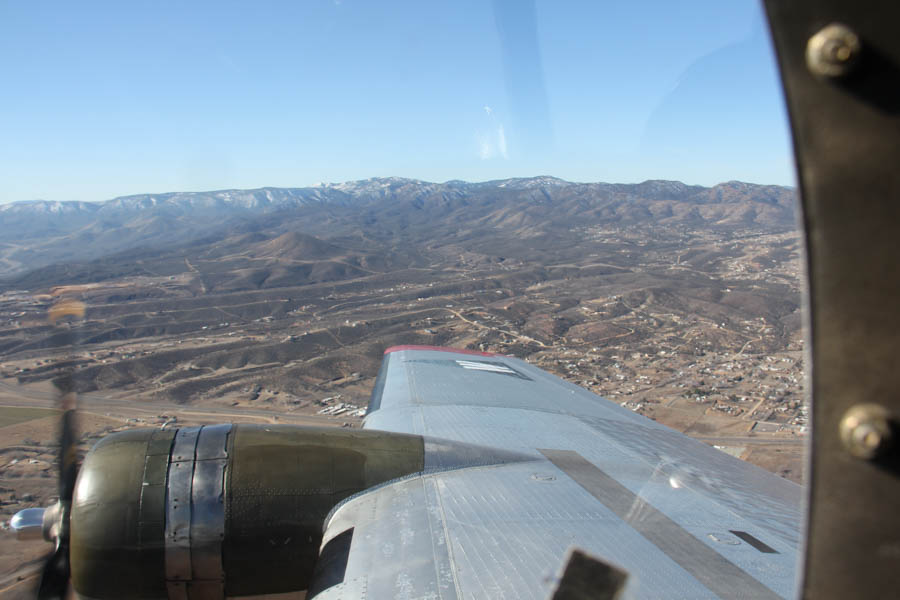
Coming in on a wing and a prayer - Great name for a song!
Hint Hint
Position #3 & #4 - The Bombardier And Navigator

The Bombardier: Did You Know? - Accurate and effective bombing is the ultimate purpose of your entire airplane and crew. Every other function is preparatory to hitting and destroying the target.
That's your bombardier's job. The success or failure of the mission depends upon what he accomplishes in that short interval of the bombing run.
When the bombardier takes over the airplane for the run on the target, he is in absolute command. He will tell you what he wants done, and until he tells you "Bombs away," his word is law.
A great deal, therefore, depends on the understanding between bombardier and pilot. You expect your bombardier to know his job when he takes over. He expects you to understand the problems involved in his job, and to give him full cooperation. Teamwork between pilot and bombardier is essential.
Under any given set of conditions -- groundspeed, altitude, direction, etc. -- there is only one point in space where a bomb may be released from the airplane to hit a predetermined object on the ground.
There are many things with which a bombardier must be thoroughly familiar in order to release his bombs at the right point to hit this predetermined target.
- He must know and understand his bombsight, what it does, and how it does it.
- He must thoroughly understand the operation and upkeep of his bombing instruments and equipment.
- He must know that his racks, switches, controls, releases, doors, linkage, etc., are in first class operating condition.
- He must understand the automatic pilot as it pertains to bombing.
- He must know how to set it up, make any adjustments and minor repairs while in flight.
- He must know how to operate all gun positions in the airplane.
- He must know how to load and clear simple stoppages and jams of machine guns while in flight.
- He must be able to load and fuse his own bombs.
- He must understand the destructive power of bombs and must know the vulnerable spots on various types of targets.
- He must understand the bombing problem, bombing probabilities, bombing errors, etc.
- He must be thoroughly versed in target identification and in aircraft identification.

Sitting in the nose.... Fine until the battle erupts!

Capturing movies of the flight
(
Movies are on page 6
)

The chin guns were operated by the bombardier

The Norden bombsight was right up front for a clear view of the terrain
Navigator: Did You Know? - The navigator sat off-set to his rear at a small map-filled desk. Both were supplied with defensive .50 caliber machine guns with the Bendix chin turret under the bombardiers control in the G model and onwards. Access to the nose was accomplished through a smallish passage way underneath the main flight deck.
Duties and Responsibilities of
the Navigator:
The navigator's job is to direct your flight from departure to destination and return. He must know the exact position of the airplane at all times.
Navigation is the art of determining geographic positions by means of (a) pilotage, (b) dead reckoning, (c) radio, or (d) celestial navigation, or any combination of these 4 methods. By any one or combination of methods the navigator determines the position of the airplane in relation to the earth.
Pilotage
Pilotage is the method of determining the airplane's position by visual reference to the ground. The importance of accurate pilotage cannot over-emphasized. In combat navigation, all bombing targets are approached by pilotage, and in many theaters the route is maintained by pilotage. This requires not merely the vicinity type, but pin-point pilotage. The exact position of the airplane must be known not within 5 miles but within ¼ of a mile.
The navigator does this by constant reference to groundspeeds and ETA's established for points ahead, the ground, and to his maps and charts.
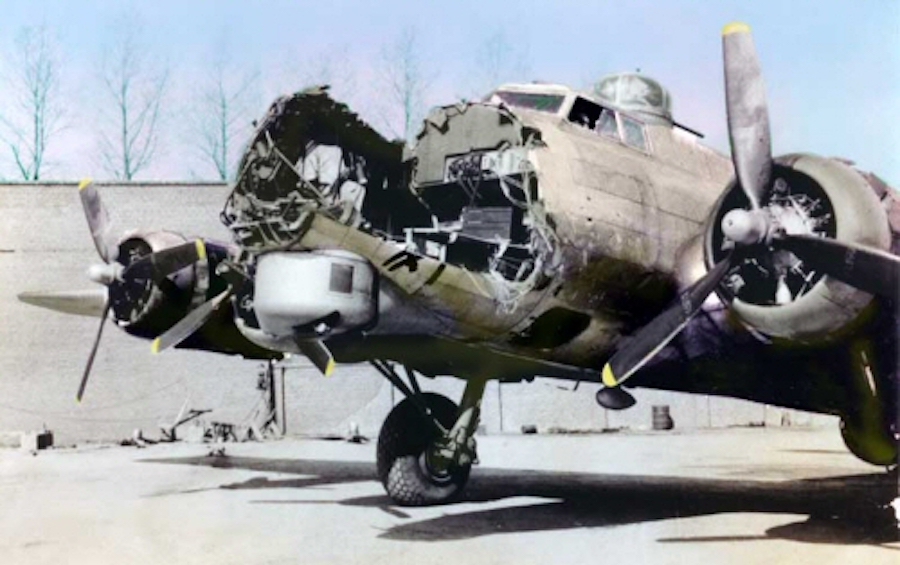
Ouch! And it flew home - 1st Lt. Lawrence DeLancey managed to get his B-17 back to England after a direct hit by flak killed two of his crew over Cologne, Germany.

The bombsight was an amazing invention
Did You Know? - During a bomb run a bombardier looked through a sighting telescope at the target. The sight was adjusted by a variable speed electric motor. The bombardier input bomb load and altitude data, then set the telescope sight over the target. The base of the sight was gyro stabilized and, by keeping the telescope on the target, aircraft movement information was fed into the sighting computer.
The computer produced course correction signals that were channeled to the pilot's panel. When the bomber was close to the target, the sight telescope was almost vertical and the computer calculated when the release angel had been reached. Then a series of electric contacts were closed and the bombs dropped automatically.
The US version of the Tachometric sight was called "NORDEN". Later models of the "Norden" channeled data directly into the auto pilot and effectively, the bomb aimer could "fly" the plane by fine adjustment of the sighting telescope. The main disadvantage of this sight was that it needed at least 20 seconds of nondeviational flight. It also lost accuracy if fire and smoke obscured the target.
Position #5 - The Engineer/Gunner
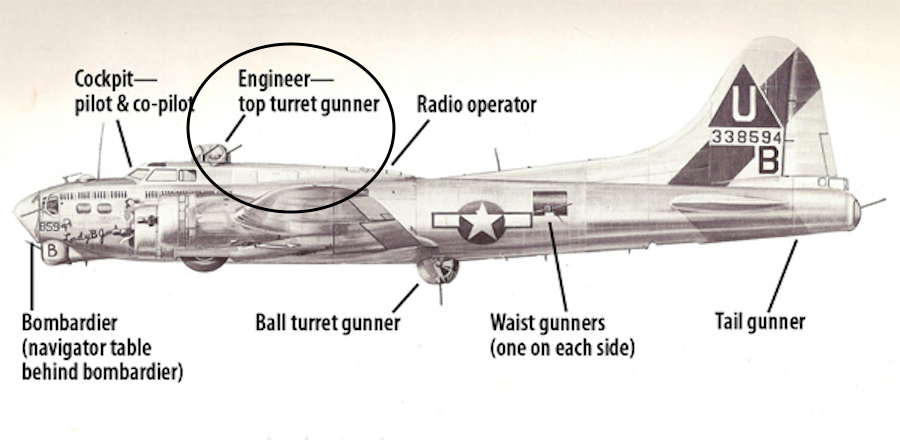
Engineer: Did You Know? - Size up the man who is to be your engineer. This man is supposed to know more about the airplane you are to fly than any other member of the crew.
He has been trained in the Air Forces' highly specialized technical schools. Probably he has served some time as a crew chief. Nevertheless, there may be some inevitable blank spots in his training which you, as a pilot and airplane commander, may be able to fill in.
Think back on your own training. In many courses of instruction, you had a lot of things thrown at you from right and left. You had to concentrate on how to fly; and where your equipment was concerned you learned to rely more and more on the enlisted personnel, particularly the crew chief and the engineer, to advise you about things that were not taught to you because of lack of time and the arrangement of the training program.
Both pilot and engineer have a responsibility to work closely together to supplement and fill in the blank spots in each other's education. To be a qualified combat engineer a man must know his airplane, his engines, and his armament equipment thoroughly. This is a big responsibility: the lives of the entire crew, the safety of the equipment, the success of the mission depend upon it squarely.
He must work closely with the copilot, checking engine operation, fuel consumption, and the operation of all equipment. He must be able to work with the bombardier, and know how to cock, lock, and load the bomb racks. It is up to you, the airplane commander, to see that he is familiar with these duties, and, if he is hazy concerning them, to have the bombardier give him special help and instruction.
He must be thoroughly familiar with the armament equipment, and know how to strip, clean, and re-assemble the guns.
He should have a general knowledge of radio equipment, and be able to assist in tuning transmitters and receivers.
Your engineer should be your chief source of information concerning the airplane. He should know more about the equipment than any other crew member -- yourself included.
You, in turn, are his source of information concerning flying. Bear this in mind in all your discussions with the engineer. The more complete you can make his knowledge of the reasons behind every function of the equipment, the more valuable he will be as a member of the crew. Who knows? Someday that little bit of extra knowledge in the engineer's mind may save the day in some emergency.
Generally, in emergencies, the engineer will be the man to whom you turn first. Build up his pride, his confidence, his knowledge. Know him personally; check on the extent of his knowledge. Make him a man upon whom you can rely

The B-17 carried up to 11,000 rounds of 50 mm ammunition!
The Engineer/Gunner had a 360 view of the top of the aircraft!
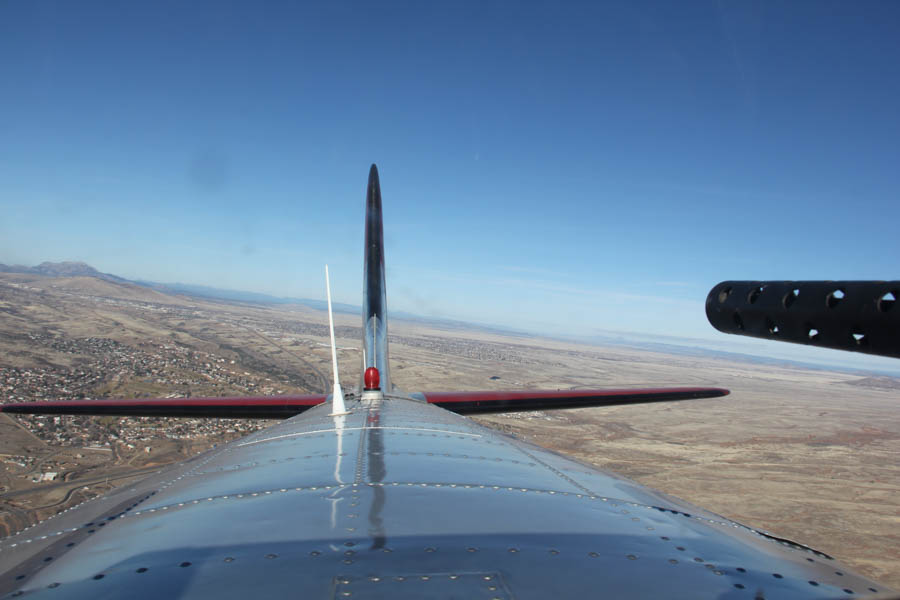
The Engineer/Top Gunner gunner was a sitting duck...
But, he did have a great view of the battles
Position #6 - The Radio Operator

Did You Know? - There is a lot of radio equipment in today's B-17's. There is one man in particular who is supposed to know all there is to know about this equipment. Sometimes he does, but often he doesn't. And when the radio operator's deficiencies do not become apparent until the crew is in the combat zone, it is then too late. Too often the lives of pilots and crew are lost because the radio operator has accepted his responsibility indifferently.
Radio is a subject that cannot be learned in a day. It cannot be mastered in 6 weeks, but sufficient knowledge can be imparted to the radio man during his period of training in the United States if he is willing to study. It is imperative that you check your radio operator's ability to handle his job before taking him overseas as part of your crew. To do this you may have to check the various departments to find any weakness in the radio operator's training and proficiency and to aid the instructors in overcoming such weaknesses.
Training in the various phases of the heavy bomber program is designed to fit each member of the crew for the handling of his jobs. The radio operator will be required to:
- Render position reports every 30 minutes.
- Assist the navigator in taking fixes.
- Keep the liaison and command sets properly tuned and in good operating order.
-
Understand from an operational point of view:
Instrument landing.
IFF
VHF. and other navigational aids equipment in the airplane. - Maintain a log.
In addition to being a radio operator, the radio man is also a gunner. During periods of combat he will be required to leave his watch at the radio and take up his guns. He is often required to learn photography. Some of the best pictures taken in the Southwest Pacific were taken by radio operators. The radio operator who cannot perform his job properly may be the weakest member of your crew -- and the crew is no stronger than its weakest member.

The ol' BC-348 radio set still looks pretty good
The radio operator sat behind the bombay at a small table

Did You Know? - The BC-348 is the 28 vdc powered version of the 14 vdc powered BC-224. The first version, the BC-224-A, was produced in 1936. Installed in almost all USAAF (and some USN , some British and some Canadian ) multi-engined transports and bombers used during the fifteen-year period from before World War II through the Korean War , BC-348 radio receivers were easy to operate and reliable.

Radios were located all over the ship
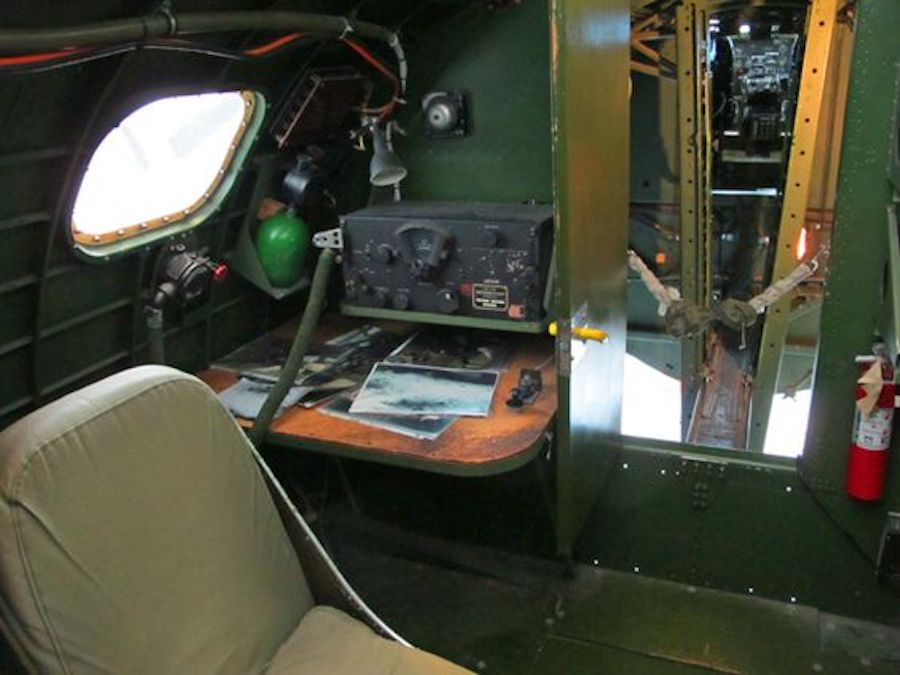
Communications was essential for the bomber to operate
The Bomb Bay is directly ahead of the radio operator
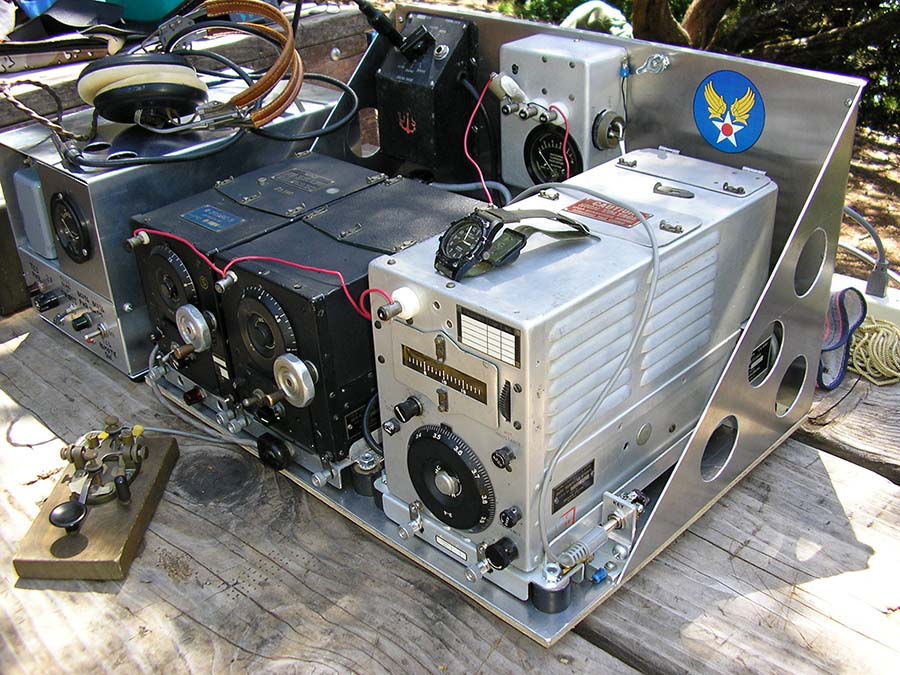
After the war, ham radio operators converted the B-17 (and other) radio
equipment for use on the ham bands.... 1000's of radios were available for peanuts
Did You Know? - The radio operator was located just behind the bomb bay and just in front of the waist section of the Flying Fortress. He had far more responsibilities than just manning the main radio gear for the aircraft however. Up until the later models of the B-17G, the radio operator had a .50 caliber machine gun located in the ceiling of his compartment that faced the rear of the aircraft. It was found that this was the least effective gun position on the aircraft since the majority of fighter attacks came from the front. Once fighter activity lessened during the latter half of the war, this gun was removed.
The radio operator primarily assisted the navigator. He had a couple instruments that duplicated those of the navigator that gave heading information. He could forward radio fixes, known as position reports, to the navigator. These fixes could come off of homing beacons or even radio stations.
As long as the navigator knew where the radio signal was coming from, based upon the heading of the signal from the radio operator, the navigator could get a fix on where the aircraft was (though granted he would need more information than just one radio fix).
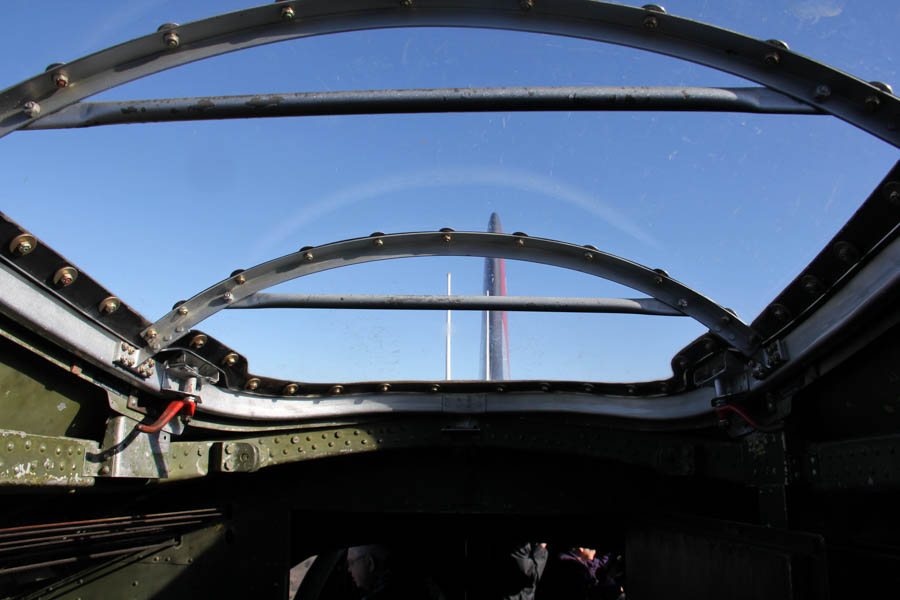
Looking up... He could see the antennas plus he also had a gun viewing upwards!
Positions #8- #10 - The Defenders (Gunners)

Did You Know? - The B-17 is a most effective gun platform, but its effectiveness can be either applied or defeated by the way the gunners in your crew perform their duties in action.
Your gunners belong to one of two distinct categories: turret gunners and flexible gunners.
The power turret gunners require many mental and physical qualities similar to what we know as inherent flying ability, since the operation of the power turret and gunsight are much like that of airplane flight operation.
While the flexible gunners do not require the same delicate touch as the turret gunner, they must have a fine sense of timing and he familiar with the rudiments of exterior ballistics.
All gunners should be familiar with the coverage area of all gun positions, and be prepared to bring the proper gun to bear as the conditions may warrant.
They should be experts in aircraft identification. Where the Sperry turret is used, failure to set the target dimension dial properly on the K-type sight will result in miscalculation of range.
They must be thoroughly familiar with the Browning aircraft machine gun. They should know how to maintain the guns, how to clear jams and stoppages, and how to harmonize the sights with the guns. While participating in training flights, the gunners should be operating their turrets constantly, tracking with the flexible guns even when actual firing is not practical. Other airplanes flying in the vicinity offer excellent tracking targets, as do automobiles, houses, and other ground objects during low altitude flights.
The importance of teamwork cannot he overemphasized. One poorly trained gunner, or one man not on the alert, can be the weak link as a result of which the entire crew may be lost.
Keep the interest of your gunners alive at all times. Any form of competition among the gunners themselves should stimulate interest to a high degree.
Finally, each gunner should fire the guns at each station to familiarize himself with the other man's position and to insure knowledge of operation in the event of an emergency.
The Ball Gunner

Quotation To Remember: The Death of the Ball Turret Gunner is a five-line poem by Randall Jarrell published in 1945. It is about the death of a gunner in a Sperry ball turret on a World War II American bomber aircraft.
From my mother's sleep I fell into the State,
And I hunched in its belly till my wet fur froze.
Six miles from earth, loosed from its dream of life,
I woke to black flak and the nightmare fighters.
When I died they washed me out of the turret with a hose.
Jarrell, who served in the Army Air Forces, provided the following explanatory note:
A ball turret was a Plexiglas sphere set into the belly of a B-17 or B-24, and inhabited by two .50 caliber machine guns and one man, a short small man. When this gunner tracked with his machine guns a fighter attacking his bomber from below, he revolved with the turret; hunched upside-down in his little sphere, he looked like the fetus in the womb. The fighters which attacked him were armed with cannon firing explosive shells. The hose was a steam hose.
The Waist Gunners


John is bouncing around the plane
attempting pictures and videos
Image what the waist gunner felt when a) in battle and b) firing the 50 cals

A little more protection with plastic over the gun site openings...
In real life, no plastic... Just -50 degree open skies

They wore heated uniforms
The Tail Gunner


The tail section was built pretty strong!
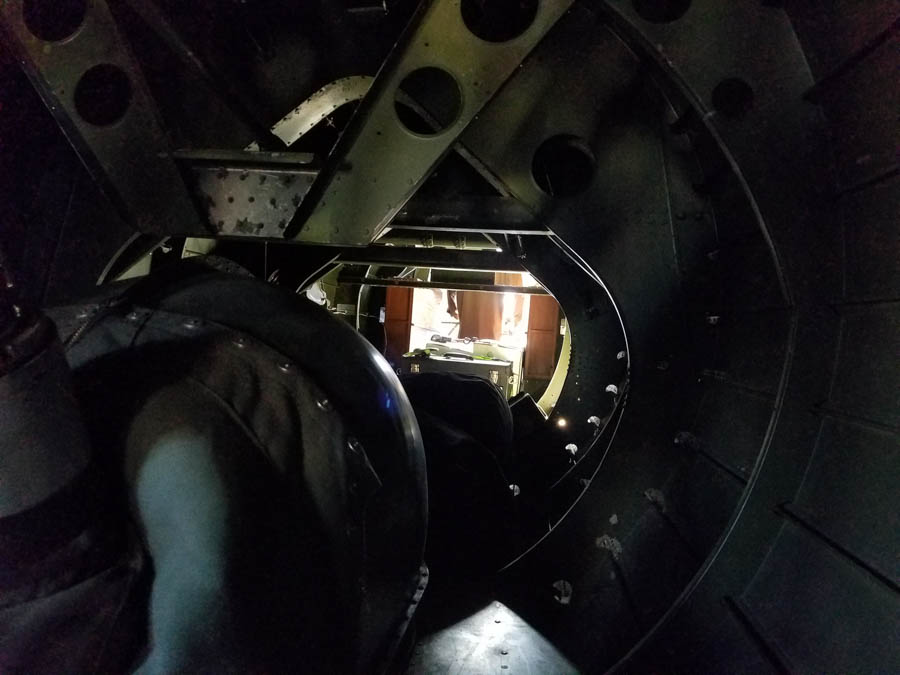
The tail gunner had to make his way through the maze of supports and structure

Wow! This was a dangerous job... Right out in the open for all to see!
The Bombay - The Business End!
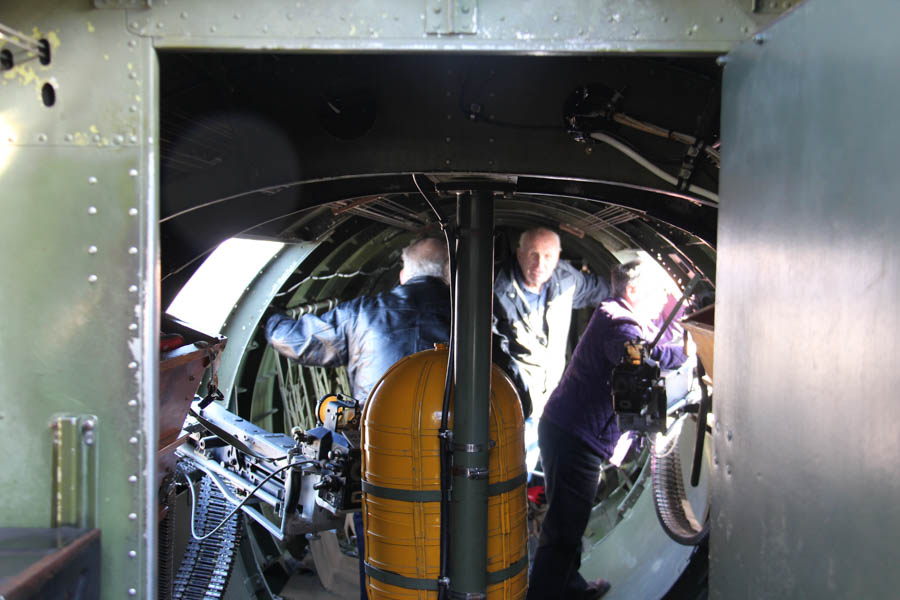
Tight quarters
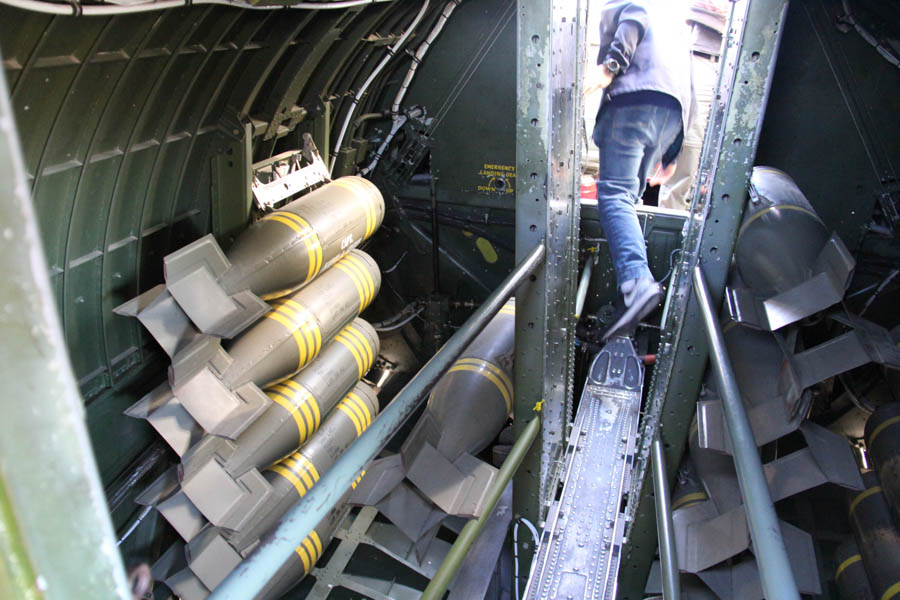
Walking through the business end of the bomber
Did You Know? - Armament galore:
Guns: 13 × .50 in (12.7 mm) M2 Browning machine guns in 8 positions (2 in the Bendix chin turret, 2 on nose cheeks, 2 staggered waist guns, 2 in upper Sperry turret, 2 in Sperry ball turret in belly, 2 in the tail and one firing upwards from radio compartment behind bomb bay)
Bombs: Short range missions (<400 mi): 8,000 lb (3,600 kg)
Long range missions (≈800 mi): 4,500 lb (2,000 kg)
Overload: 17,600 lb (7,800 kg)
Coming In For The Landing

Making a turn over the desert!
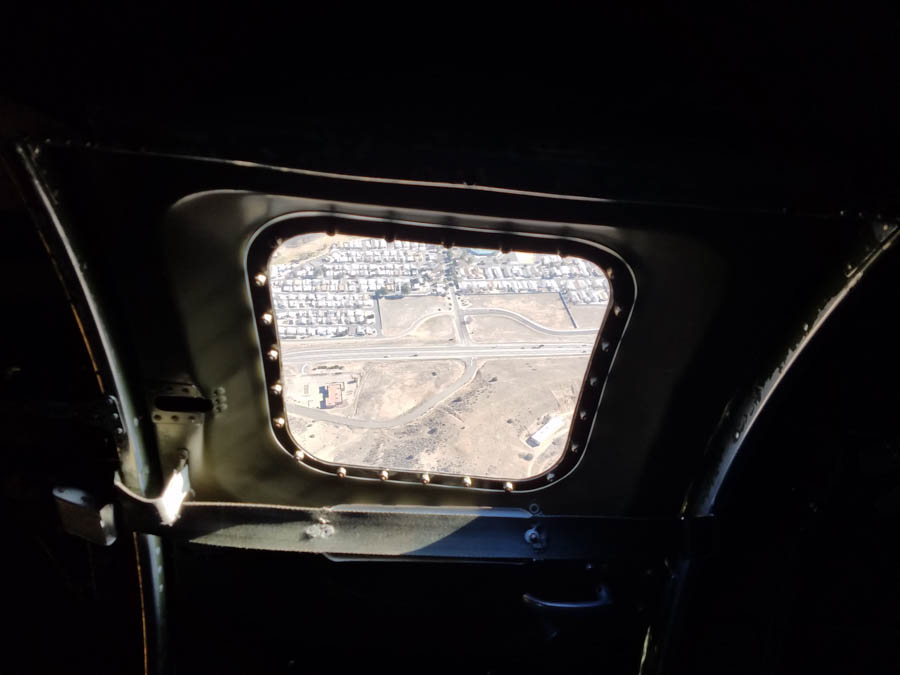
The door had a small window in it

Wonderful visibility today!
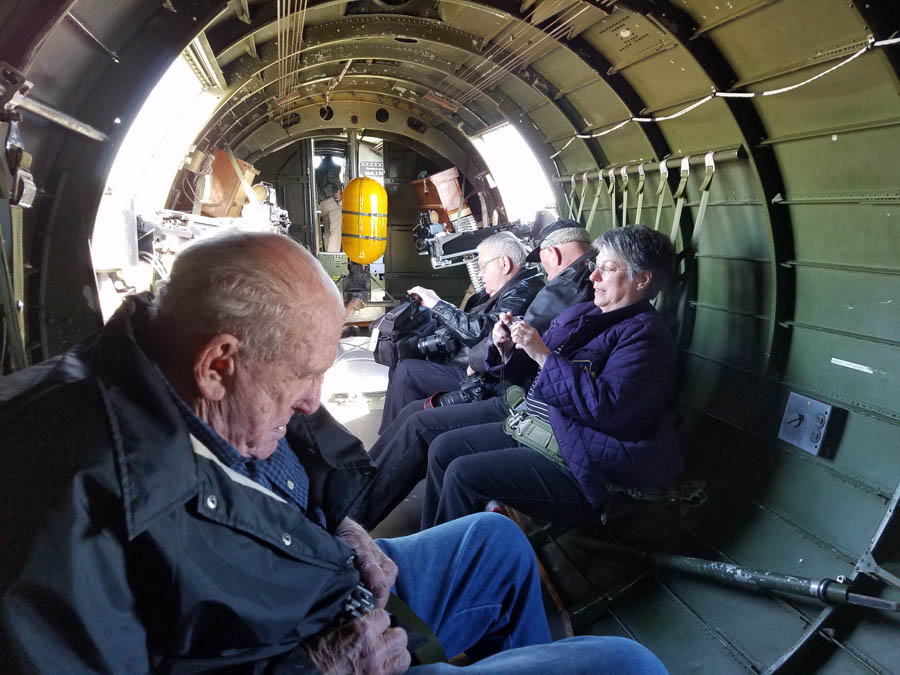
Buckle up... We are going to be landing soon!
(This is a view of the ball turret looking toward the front of the plane. The yellow tank is the ball turret gunners oxygen supply. Both waist guns are visible in this picture. The bulkhead door straight ahead leads into the radio compartment.
)
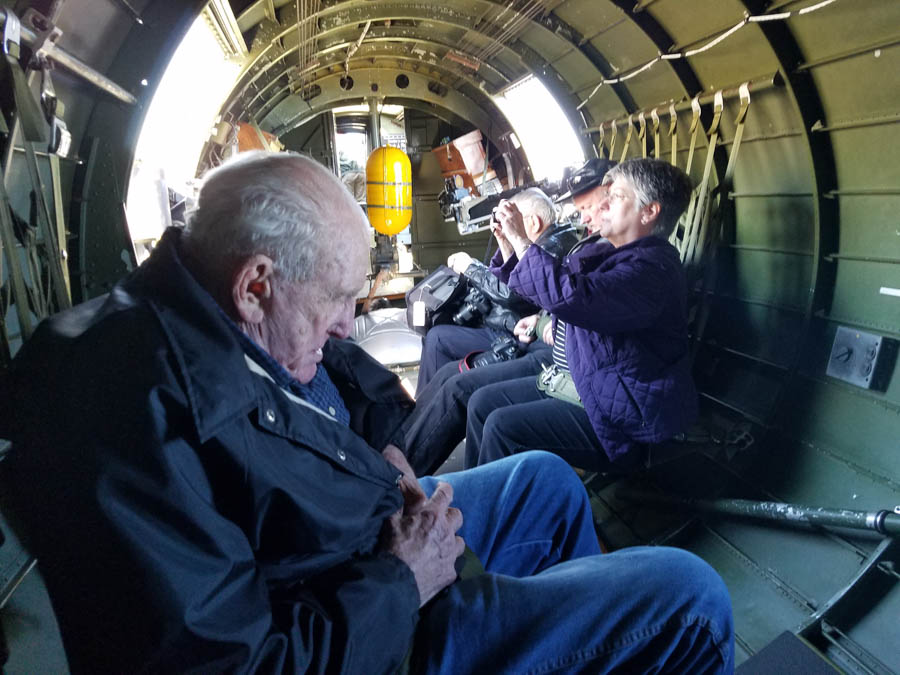
These are the VIP seats!

Hans checks out the bombs!
No Hans, you CANNOT bomb Arizona today!

Typical After-Action-Report from November 17th 1944
On The Ground Again
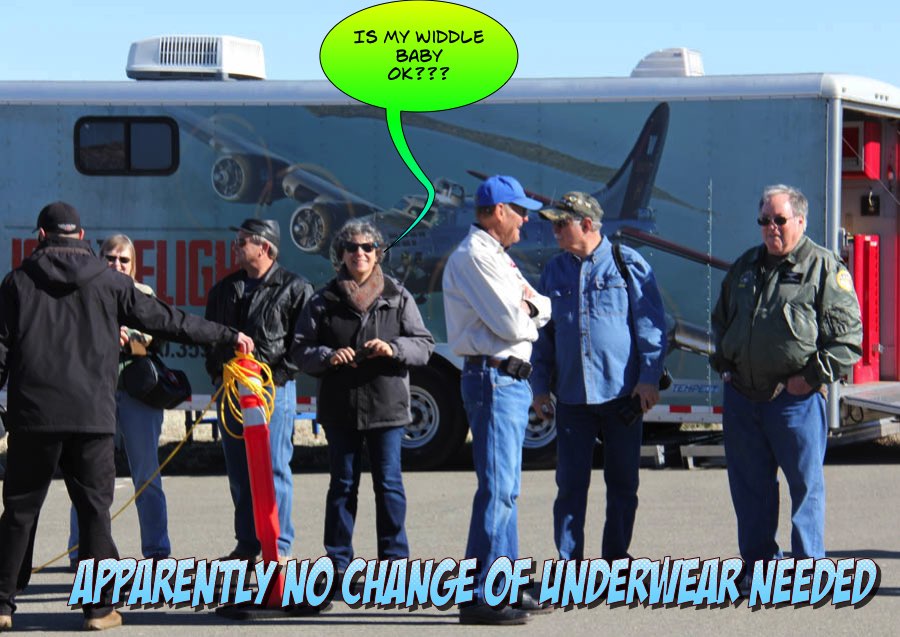
Kerstin awaits her man!

Taxing over for another flight today

Loaded and ready to go!
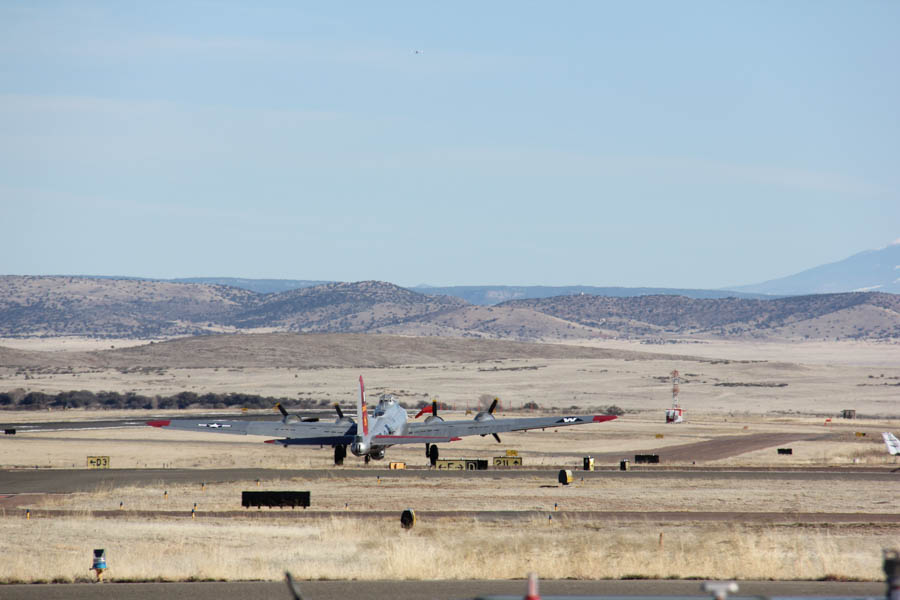
To the end of the runway!

Lookout here it comes!

Thousands (4,800 HP) of horsepower raise the fortress into the air
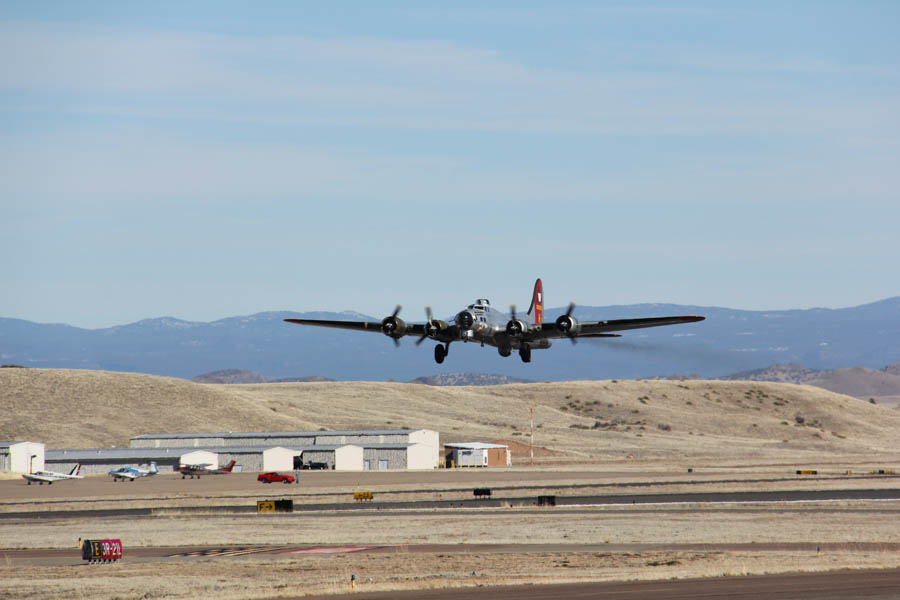
No 45 degree angle of attack takeoffs in those days!
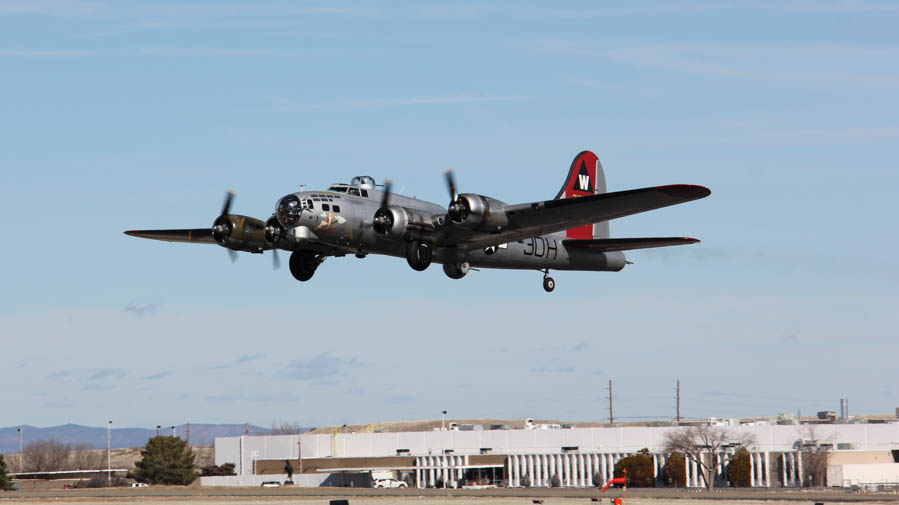
Wheels up!

We have the proof! We flew all over the desert!

High in the sky.. See you later!
(I think they are running a red light?!"

